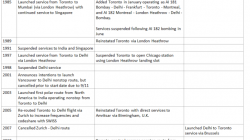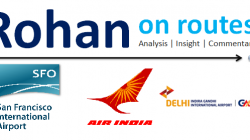Air India is an airline that never seems to shock anyone these days with its never-ending drama. Plagued by operational, financial, political and HR-related issues, just to name a few, Air India has likely watched the sun set on any hopes of successfully joining the ranks of Emirates, Singapore or Turkish in terms of becoming a profitable and high-regarded global power player, at least in the near-future.
However, there are still a few bright patches, although few and far between, that may help AI get back on its feet, one of which is its fleet renewal program. One of AI’s largest struggles in recent years has pertained to its widebody fleet type. Currently, Air India operates 33 widebody planes: 5 Boeing 747-400s, 12 Boeing 777-300ERs, 8 Boeing 777-200LRs, 2 A330-200s, and 6 Boeing 787s, with an additional 21 on order. Air India has been trying to sell off its 777-200LRs since they have failed to generate profits since they were launched back in the late 2000s.
AI has relied heavily on the advent of the 787 to help improve margins and yields on its long-haul routes, and the grounding of the Dreamliner created a few painful months in the intermedium. However, with the dreamliner back on the market, Air India has already embarked on plans to turn the corner in launching new intercontinental routes to tap into markets with large potential, namely India-UK and India-Australia.
Last week, Air India announced new nonstop services from Delhi to Birmingham, United Kingdom. and to Sydney and Melbourne, Australia, commencing as soon as next month. Birmingham will go live on August 1, operating 4 times weekly, and Delhi-Sydney and Delhi-Melbourne will launch on 29 August (30 August from Australia) operating daily. The new routes to Sydney and Melbourne will be linked in a triangular fashion, operating 3-weekly in one direction and 4 weekly in the opposite direction.
All three of these are markets that were once served by Air India at once point. Air India previously flew to BHX operating a thrice weekly Delhi – Amritsar – Birmingham – Toronto route, utilizing a 777, which ended in October 2008. The route was primarily designed to target the large Punjabi/Sikh populations living in both Canada and in the U.K.
The schedule for Birmingham is as follows:
AI113 DEL 1330 – 1800BHX 788 x357
AI114 BHX 2130 = 1005DEL 788 x357
Air India’s service resumption to Australia comes after 16 years of dormancy. The carrier last operated services to Sydney in January 1991, providing a 1 weekly Delhi – Singapore – Sydney frequency utilizing a Boeing 747. Air India also operated services to Melbourne (terminated in April 1981) and Perth (terminated in June 1997), all according to AirlineRoute.net.
The re-launched services to Melbourne and Sydney will operate daily in a triangular fashion, flying DEL-SYD-MEL-DEL four times weekly and DEL-MEL-SYD-DEL three times weekly.
The schedule for Australia is as follows:
AI312 DEL1345 – 0630+1SYD0800+1 – 0935+1MEL 788 x357
AI311 SYD0800 – 0935MEL1050 – 1835DEL 788 x146
AI312 DEL 1300 – 0530+1MEL0700+1 – 0830+1SYD 788 357
AI311 MEL 0700 – 0830SYD1000 – 1810DEL 788 146
The interesting thing is, now Air India will officially once again become a player in the Kangaroo route from Europe to Australia (although this has been informally re-dubbed as the ‘Falcon Route’ ever since Qantas tied up with Emirates last spring).
Allegedly, the connections are well-timed for passengers traveling from Paris, Frankfurt and London to Australia, but the return itinerary involves an overnight in Delhi on the return. It is questionable, if not doubtful, whether AI will be able to replicate a hub in Delhi that can rival those in Singapore, Hong Kong, Bangkok, Kuala Lumpur, etc. between Europe and Australia, but in the interim, at least AI is attempting to recreate presences in each of these regions to and from India.
Moreover, even without ideally timed connections heading back towards Europe for inbound traffic from Australia, Air India will still be able to capture a sizable portion of onward traffic to domestic points within India as well as the Gulf Coast/Middle East/Southeast Asia region.
The Birmingham, U.K. flight is nothing unusual given the fact that AI has a long-established presence in Britain (serving London Heathrow for decades) as well as a prior stint in Manchester. However, the return to Australia certainly signifies something much more interesting.
Put simply, both Qantas and Air India have previously entered and exited the India-Australia market. According to a CAPA analysis published last fall, the market potential is huge, but reasons for lack of direct air services are fairly salient: the traffic is heavily VFR-oriented (visiting friends and relatives) which generally implies leisure/non-business price/budget-conscious travelers who will favor purchasing 1-stop connecting itineraries for a lower fare over a more expensive nonstop option. As I mentioned in my trip report flying Thai Airways from Delhi to Bangkok last summer, the vast majority of the passenger makeup on my flights between the two cities appeared to be connecting to/from Australia over Bangkok in both directions.
Additionally, financial difficulties experienced by both Qantas and Air India have created major challenges for opening up new international routes. Qantas in particular has pulled down a large portion of its global network as it restructures. Its services to India were a casualty of this, as its flight to Mumbai was axed in May 2012.
However, the 787 is the key to the lock, and the economics of the Dreamliner will likely provide the breakthrough to link both the countries profitably. The current air service agreement between both nations, according to CAPA, permits 6,500 weekly seats from each country, and allows Australian airlines to serve Delhi, Mumbai, Kolkata, Chennai, Bangalore and Hyderabad, and Indian carriers to operate into Sydney, Melbourne, Brisbane and Perth.
Supposedly, Indian tourism in Australia is on the rise, growing at approximately 12.3% annually, according to CAPA. On the Australia side, India remains the country’s largest unserved market, with Sydney recording 120,000 visitors from Delhi and 60,000 visitors from Mumbai in 2011.
Putting all of this together, I think Air India has finally got something going in the right direction.
The airline will still need to contend with a large pre-existing volume of competition between India and Australia on 6th-freedom provideres. A simple ITA search for a 1-week round-trip from Delhi to Sydney in January displays connecting itineraries offered on China Eastern, Malaysia, Thai, Singapore, China Southern, Emirates, Cathay Pacific and Asiana. Fares seem decently priced starting in the $1,000 USD range. Although generally nonstop flights tend to price out the highest, as it is the most convenient, Air India is still displaying the cheapest fare at $1,008.
Looking at the list, that is a LOT to choose from. My guess is that Thai, MAS and Chinese airlines are going to be the most aggressive in terms of under-cutting AI to snag the bottom-barrel feeding traffic. I’m not currently sure how much premium airlines are charging on current India-Australia itineraries, but I am sure that its going to turn into a bloodbath. Sources indicate that SIA is currently the largest beneficiary of India-Australia traffic at the moment, which is no surprise that Singapore, often known for charging premium fares, is instead charging a relatively inexpensive fare above and matching at the competition level.
Still, Air India will be padded by the optimal mix of seats (256) to serve this market and be able to siphon off the right amount. There are also rumors that AI is interested in launching a codeshare partnership with Qantas, which would be a HUGE boon for both carriers, if achieved. This would bring a lot of incremental value to the route by allowing Air India to sell tickets on Qantas metal to more cities beyond SYD and MEL, and vice-versa. Qantas currently appears to code-share on Jet Airways services operating between Singapore and Delhi and Mumbai, which is interesting as it appears displayed on ITA.
At any rate, this is a great development for Air India, and I’m happy to see that they are returning to Australia and expanding in Europe so quickly. Rumors are that AI expansion to Milan, Rome and Moscow are also in the pipeline. Stay tuned for more updates as they come.





